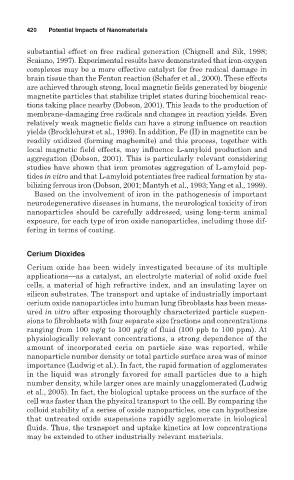Page 440 - Environmental Nanotechnology Applications and Impacts of Nanomaterials
P. 440
420 Potential Impacts of Nanomaterials
substantial effect on free radical generation (Chignell and Sik, 1998;
Scaiano, 1997). Experimental results have demonstrated that iron-oxygen
complexes may be a more effective catalyst for free radical damage in
brain tissue than the Fenton reaction (Schafer et al., 2000). These effects
are achieved through strong, local magnetic fields generated by biogenic
magnetite particles that stabilize triplet states during biochemical reac-
tions taking place nearby (Dobson, 2001). This leads to the production of
membrane-damaging free radicals and changes in reaction yields. Even
relatively weak magnetic fields can have a strong influence on reaction
yields (Brocklehurst et al., 1996). In addition, Fe (II) in magnetite can be
readily oxidized (forming maghemite) and this process, together with
local magnetic field effects, may influence L-amyloid production and
aggregation (Dobson, 2001). This is particularly relevant considering
studies have shown that iron promotes aggregation of L-amyloid pep-
tides in vitro and that L-amyloid potentiates free radical formation by sta-
bilizing ferrous iron (Dobson, 2001; Mantyh et al., 1993; Yang et al., 1999).
Based on the involvement of iron in the pathogenesis of important
neurodegenerative diseases in humans, the neurological toxicity of iron
nanoparticles should be carefully addressed, using long-term animal
exposure, for each type of iron oxide nanoparticles, including those dif-
fering in terms of coating.
Cerium Dioxides
Cerium oxide has been widely investigated because of its multiple
applications—as a catalyst, an electrolyte material of solid oxide fuel
cells, a material of high refractive index, and an insulating layer on
silicon substrates. The transport and uptake of industrially important
cerium oxide nanoparticles into human lung fibroblasts has been meas-
ured in vitro after exposing thoroughly characterized particle suspen-
sions to fibroblasts with four separate size fractions and concentrations
ranging from 100 ng/g to 100 µg/g of fluid (100 ppb to 100 ppm). At
physiologically relevant concentrations, a strong dependence of the
amount of incorporated ceria on particle size was reported, while
nanoparticle number density or total particle surface area was of minor
importance (Ludwig et al.). In fact, the rapid formation of agglomerates
in the liquid was strongly favored for small particles due to a high
number density, while larger ones are mainly unagglomerated (Ludwig
et al., 2005). In fact, the biological uptake process on the surface of the
cell was faster than the physical transport to the cell. By comparing the
colloid stability of a series of oxide nanoparticles, one can hypothesize
that untreated oxide suspensions rapidly agglomerate in biological
fluids. Thus, the transport and uptake kinetics at low concentrations
may be extended to other industrially relevant materials.

